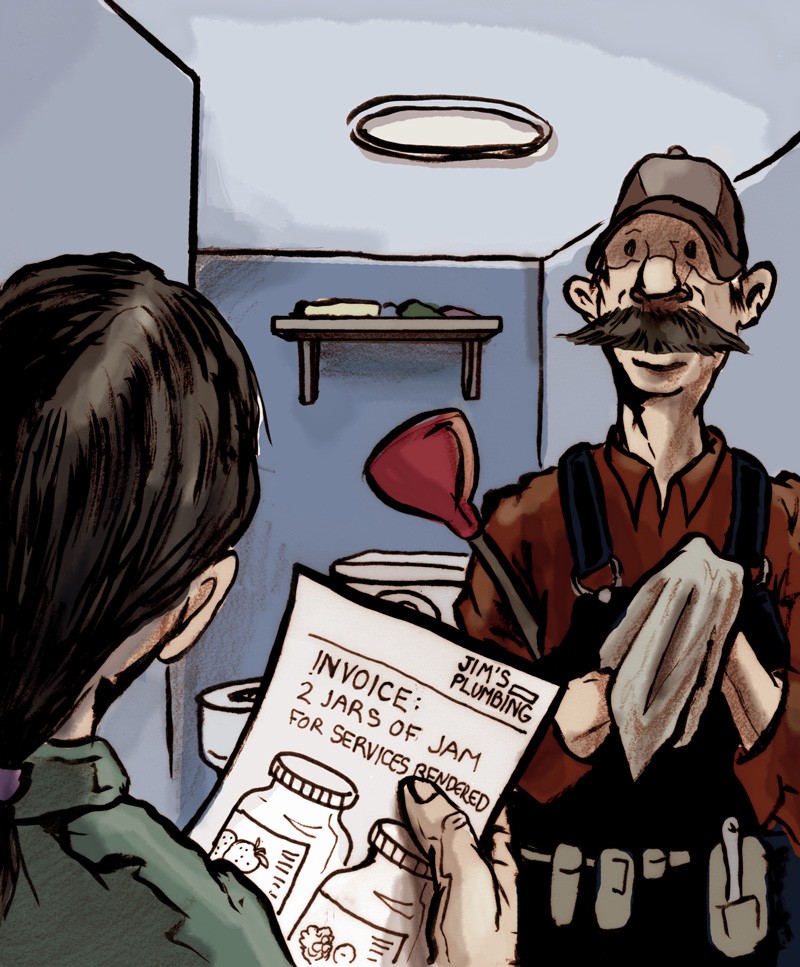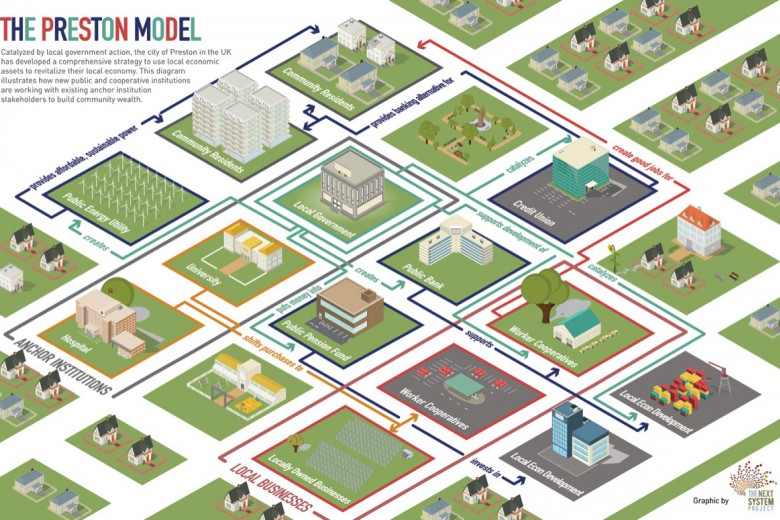
When I first heard about the Saugeen Trading Community, I was intrigued. I had heard whispers of alternative, community-based currencies in my readings and discussions about community development, but had never had the opportunity to see them in action. Could alternative systems of exchange like the Saugeen Trading Community become valuable tools in localizing our economies and strengthening our communities? Could they work to democratize our economic exchanges by keeping money in local hands and out of corporate coffers? With unprecedented global imbalances, rapidly rising oil prices, the decline of the U.S. dollar, and the word “recession” on the tongues of newscasters across North America, could these local systems of exchange offer a solution? I was compelled to find answers.
Lillian Burgess and Jon Radojkovic, co-founders of the Saugeen Trading Community, settled in southwestern Ontario in 1984 to fulfill their dream of living on a farm and building their own house. Drawn to the region mainly because of the affordability of land compared to the west coast and the availability of work compared to the east coast, the couple was “looking for other ways to survive economically.”
Burgess began thinking about alternative forms of exchange when she attended a permaculture course in 1993. Permaculture is an ecosystem-based approach to agriculture and to life in general that emphasizes self-sufficiency, sustainability and the natural interdependent relationships among all living things. It was through this course that Burgess was introduced to the concept of LETS (Local Exchange Trading Systems). LETS networks allow members to exchange goods and services with others within the network. In lieu of exchanging hard currency, transactions are recorded in a central location. LETS is different from bartering in that it does not require a direct trade with another member, but rather facilitates diverse transactions among a dispersed network of individuals. For instance, one member might earn credit by doing yardwork for someone, and then spend that credit on some homemade jam from someone else.
The potential financial benefits of a trading community, as well as the principle of keeping currency local to build a more vibrant and diverse local economy, appealed to Burgess, and she began to discuss the idea with those around her. Thirty-odd people attended the first meeting, from which a core group of five or six people became key organizers.
Books, bikes, and shiitake mushrooms
Fifteen years later, the Saugeen Trading Community now consists of over 100 members, with an even larger community of supporters who participate in activities organized by the trading community and attend market days. Each member receives an annual list of all members’ names and contact information, along with a “goods and service list,” which lists everything people are offering, arranged by category. The list includes everything from books to bikes, from apple pie to plumbing, reiki, French lessons, and child care. The values of goods and services are set by the people offering them in “Saubucks,” which are monetarily equivalent to the Canadian dollar.
The heart and glory of the Saugeen Trading Community is market day, held three times annually at a local community centre or arena. People mill about the tables, taking what they want and marking down their own transactions on the vendor’s record sheet. Since most of the vendors are also buyers (the last market day saw 38 vendors and 59 buyers), tables are often left unattended and the honour system prevails. People who are not members of the trading community are welcome to attend market day and pay in cash. Between transactions, people marvel at how much the children have grown while munching on home-cooked food offered by a few local cooks.
Market days are accompanied by high spirits and a sense of freedom. “I feel rich, because I can buy anything there,” says Burgess with a hint of pride. She is famous in the community for her shiitake mushrooms; Peter Faulkner, another trading member, dubs Burgess “our shiitake mushroom queen.”
Gillian Inksetter, a member of the core group who trades vegan baking, sewing alterations, and French lessons, is responsible for organizing each market day. She says that “attending market day is crucial” to feeling a part of the trading community. It’s where people really get to know one another and the services that are being offered. Outside of market day, explains Inksetter, people tend to go to people they already know for their transactions; market day brings all members together to display their goods and services for everyone to see, and is also an important vehicle for interaction with non-members.
Serene Saugeen
“Saugeen” refers to the Saugeen River watershed in southwestern Ontario, and the Saugeen Trading Community covers a mostly rural area bordered roughly by the towns of Owen Sound in the north, Ayton in the south, and Paisley and Flesherton to the west and east—all within a half-hour drive of one another.
Burgess describes the area as a traditional farming economy, with a small but vibrant arts community. The region has attracted several waves of back-to-the-landers, and Burgess speaks of a kind of alternative undercurrent that swirls beneath the agricultural heritage of the region—a Waldorf school in Durham, the co-op organic food store, and something called “symphony in the barn.” In Burgess’s words, the Saugeen Trading Community “just fits” with that undercurrent.
To a certain extent, the sense of community on which the trading community thrives has existed in this area for years. People look out for one another, and are there to lend a hand when a neighbour is in a bind. “That’s just the nature of the rural community,” says Faulkner. A self-proclaimed “refugee from Toronto” and active member of the Saugeen Trading Community, Faulkner offers skilled trades such as plumbing, electrical work and carpentry, as well as web design and computer coaching.
Retired hippies and urban expats
Despite members’ enthusiasm about the Saugeen Trading Community’s benefits, it is surprisingly difficult for new people to join. Members are decidedly blasé about expanding their membership, preferring it to grow slowly and organically, through word of mouth. Faulkner estimates that, of a sample of 100 citizens-at-large in the region covered by the trading community, maybe five or six have heard of the trading community.
“It’s not that we don’t want to expand it,” Faulkner clarifies. “It’s that we don’t want it to lose its central mandate by becoming excessively large; we don’t want to become bureaucratic.”
Almost all new members come to the community through an existing member, who can vouch for that person’s integrity, but there is still a rather strict application process. In the rare case that a prospective member does not know any existing members, she or he is assigned a mentor.
Prospective members have to demonstrate that they have something to offer and that they are willing to commit to using the exchange network, in order to prevent incidences of people running up large debts and then taking off.
Many trading community members moved to the area as adults, attracted, like Burgess and her husband 24 years ago, by the affordability of land in the area, the quiet landscape and tranquil lifestyle, and the alternative-minded community that was forming there.
“A lot of us are retired hippies,” quips Faulkner, who relocated to the countryside about 10 years ago with his wife to get away from the “high-speed, high-pressure environment” of urban life. Faulkner’s main interest in the Saugeen Trading Community is the social network of like-minded individuals that it offers. “We have the same kind of attitude: supportive of things local, taking on responsibility for creating one’s own community, not disengaging but rather engaging in the life of your community, trying to work outside the corporate machine, trying to create. . . .” He pauses. Community was the word on his lips. “Well, not trying to create it; we already live it, you know. We are a community.”
Outsiders’ club?
It is difficult to know whether the Saugeen Trading Community is a mere collection of like-minded people who have moved from elsewhere and share a certain world view—a kind of outsiders’ club that has merely transplanted its ideals into this new landscape—or if its presence in the region has had any real impact on the community-at-large.
There are a great number of rural poor in the Saugeen area, and Burgess admits that being inclusive of this low-income population is an ongoing challenge. She says that committing to an alternative system of exchange requires considerable economic stability. At first, this seems like a contradiction to me: shouldn’t the ability to trade for your goods and services, rather than fork over cash, give you more economic stability? I ask Gillian Inksetter, the vegan baker.
“To an extent,” she replies. “There’s a certain level of debt that you’re allowed to carry in Saubucks [interest-free]. But you still have to have something to offer.” Trading does not mean free stuff, and offering something that others want often requires a cash investment.
In addition, the value of the goods offered through the trading community, because they are local, unique, and often organic, can come with a higher price tag equivalent than goods bought at the supermarket or the mall.
These barriers to entry mean that the lower-income neighbours of trading community members, who might have less cash or time or fewer skills to invest, are excluded from the economic cushion that the community offers those who can afford to join.
On the other hand, the Saugeen Trading Community’s Christmas market day, held at a local arena, attracts a lot of non-members from the larger community, many of whom have never heard of Saubucks, and simply come in to do some shopping. In addition to being an opportunity for these people to purchase locally produced, one-of-a-kind Christmas gifts, it is a chance for the trading community to provide alternatives to corporate consumer culture to people for whom otherwise, according to Inksetter, “the choice is Wal-Mart or nothing.”
Mixed benefits
When asked how their involvement with the Saugeen Trading Community has impacted them, it was the social benefits of the community that members consistently touted first: the comfort of being surrounded by people who share similar interests and world views, of knowing that those people will come forward if you find yourself in a bind, of watching other people’s children come into their own, and of having this guaranteed group of friends.
In addition to their market days, the trading community organizes other social events throughout the year, including regular potlucks, equinox celebrations, and summer feast days.
Children in the community undoubtedly benefit from exposure to an alternative to consumer culture—sometimes in spite of themselves. Inksetter points to the impact the community has had on her 17-year-old daughter, whom she describes as “violently opposed to anything she would call ‘hippie,’ including the trading community.” But her opposition recently softened when she was looking for yoga lessons, and asked Inksetter to ask her “hippie friends in that weird money thing” if there were any yoga classes on offer.
In reality, the economic and the social are fully integrated in this community, and an emphasis on the social benefits does not invalidate the economic benefits. The total amount of Saubucks circulated last year, among just over 100 people, was $60,000—no small sum.
Living a simpler life in rural Ontario has allowed Faulkner to adjust to a severe cut in income, from the $40-50,000 per year he was earning in the city to the $10,000 that he and his wife now share. “We’ve learned to do this,” he says with contented nonchalance, emphasizing that the Saugeen Trading Community has played a significant role in their transition.
Works-in-progress
My conversations with members of the Saugeen Trading Community brought my idealist impulses back down to earth. I am inspired by what they are doing, in the same way that I am inspired by any group of people working together to create their visions of a better world. I was also reminded, though, that all attempts at building a better world are works-in-progress. The Saugeen Trading Community struggles with the same debates as so many other social and environmental movements: how can we be inclusive in a society that has been set up to exclude? How do we expand grassroots movements without getting bogged down in bureaucracy?
These are difficult questions that no single project can expect to answer alone. Yet, at a time of global economic instability, the efforts of initiatives like the Saugeen Trading Community have never been more relevant. They may not have all the answers, but they could certainly teach the rest of us a few things about the importance of a strong and reliable socio-economic support network for those times when the rest of the world feels increasingly unreliable.
Shayna Stock is the publisher of Briarpatch Magazine.
The Saugeen Trading Community and the Calgary Dollar (p. 20) are not alone. Around the world, thousands of communities have created their own currencies. Some other well-known examples include Ithaca HOURS (www.ithacahours.org) in Ithaca, New York, and the Salt Spring Dollar (www.saltspringdollars.com) on Salt Spring Island, British Columbia.






